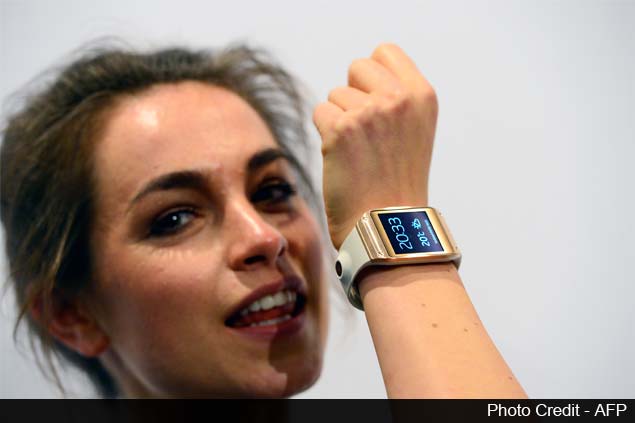- Home
- Others
- Others Features
- Coming in 2014: Extremely smart watches and wearable TVs
Coming in 2014: Extremely smart watches and wearable TVs

But 2014 has a lot of promise.
Predicting the future is a lot more difficult than evaluating the past, but you could wake up on Jan. 1, 2015, in a different digital winter wonderland.
No, you won't lie in bed while your humanoid robot helper makes you bacon and eggs and walks the dog - which is also possibly a robot made by Google. That's more of a 2035 prediction. But you might wake up to the call of a watch on your wrist - not your cellphone on your night table. This year we've seen some efforts at smartwatches, like those made by Pebble; next year, these gadgets could look a lot better.
(Also see: Pebble adds iOS 7 notifications; smartwatch now shipping globally for $150)
"Smartwatches, which connect to your smartphone, are going to create an entirely new category of computing in the coming year," said Sarah Rotman Epps, a former Forrester analyst who specializes in wearable computing. She noted that the long-awaited Apple smartwatch, which is expected to be announced in 2014, could change the way we engage with our wrist in the same way Apple changed the cellphone industry in 2007.
(Also see: Apple's iWatch coming in 2014, to be made in Taiwan)
Smartwatches will allow us to peer at messages without having to pull cellphones out of our pockets or purses. They will make it easier to monitor our health with heartbeat and movement sensors, recording daily how much we have exercised, or how much we haven't.
According to Citigroup, the global watch industry generated $60 billion in sales in 2013. Numerous research estimates expect the smartwatch industry to generate billions more in revenue for consumer tech companies in 2014.
Your cellphone next year will look almost exactly the same as the one in your pocket today - though slightly larger and a little slimmer. But the software on it will be a bit smarter because of improved location sensors. Rather than your having to look at your phone all the time, your phone will start letting you know when you need to look.
Foursquare, the location-based social network, is at the forefront of this innovation. Its app works in the background to corral different pieces of information - including your location, the time of day and where your friends have been - and then makes suggestions for what to do. "It looks like you're near the Sightglass Coffee," the company's app says if I walk by a coffee shop in the morning, "Your friend Dennis has been there and recommends the cappuccino."
Now imagine all your apps start doing this? Twitter could tell you when a news event happens near your house. Facebook could let you know if your friends are saying "congratulations" to someone's specific post - and you should too. Your phone automatically could keep emails, texts and phone calls at bay while you're sitting down for dinner with the family, all by sensing that your spouse and children's phones are in the dining room at the same time in the evening.
Smartphones are also expected to get other kinds of unusual sensors next year. Benedetto Vigna, a general manager at STMicroelectronics, a company that creates sensors for mobile devices, said 2014 would be when we would start to see mood-detecting sensors in phones. Imagine playing a video game that determines your excitement level and adjusts the experience accordingly, he said.
What about the home?
Until now, television screens have been pretty standard sizes and shapes: rectangular. While that won't change in 2014, we will probably see prototypes of something different.
"We've been working on flexible displays for more than a decade, and this past year we finally came up with solutions," Peter Bocko, the chief technology officer for Corning Glass Technologies, said earlier this year. This means screens could wrap around clothing we wear or the packages we buy.
In our homes, this flexible technology could translate into wallpaperlike screens that can be stuck to a wall.
But don't be alarmed if you sit down to enjoy a nice cup of tea in front of your new flexible display and hear a buzzing sound outside: That's probably your neighbor's drone inspecting the back garden to see if his grass is greener than yours.
Till now, drones have been mostly used by hobbyists and photographers, but the Federal Aviation Administration is expected to issue rules for expanded commercial drone use next month.
(Also see: Amazon drone delivery vision faces legislative, technological hurdles to fruition)
Jonathan Downey, the chief executive of Airware, which makes drones, said we will then start to see people use these vehicles for agriculture and farming or to reach places that are dangerous for human workers today. Rooftop inspection, for example, could be done with high-resolution thermal imaging sensors attached to a drone.
Downey predicted that any privacy concerns about drones would abate.
"When GPS first came out from the government, people saw it as something that could track them, and they said absolutely not," Downey said. Yet now, we all have GPS in our cars and smartphones. "I think we'll see something very similar happen with drones."
This year we did see the improvement of 3-D printers that can make physical objects from digital files. In 2014, we could start to see these devices become a fixture in our homes, just as inkjet printers became a norm in the late 1980s.
According to Gartner, the research firm, consumers and companies will spend more than $600 million on 3-D printer-related products in 2014.
(Also see: Most promising 3D printing applications)
What will you use these for? Maybe you'll make your own iPhone covers rather than buy them from stores, print out new salt and pepper shakers or download a pattern and print a new part for your drone.
And who knows, if you do get a 3-D printer next year, maybe you could start downloading the parts for your very own humanoid robot helper that can make your breakfast and walk your dog in 2015.
© 2013, The New York Times News Service
Catch the latest from the Consumer Electronics Show on Gadgets 360, at our CES 2026 hub.
Related Stories
- Samsung Galaxy Unpacked 2025
- ChatGPT
- Redmi Note 14 Pro+
- iPhone 16
- Apple Vision Pro
- Oneplus 12
- OnePlus Nord CE 3 Lite 5G
- iPhone 13
- Xiaomi 14 Pro
- Oppo Find N3
- Tecno Spark Go (2023)
- Realme V30
- Best Phones Under 25000
- Samsung Galaxy S24 Series
- Cryptocurrency
- iQoo 12
- Samsung Galaxy S24 Ultra
- Giottus
- Samsung Galaxy Z Flip 5
- Apple 'Scary Fast'
- Housefull 5
- GoPro Hero 12 Black Review
- Invincible Season 2
- JioGlass
- HD Ready TV
- Laptop Under 50000
- Smartwatch Under 10000
- Latest Mobile Phones
- Compare Phones
- Tecno Spark Go 3
- iQOO Z11 Turbo
- OPPO A6c
- Samsung Galaxy A07 5G
- Vivo Y500i
- OnePlus Turbo 6V
- OnePlus Turbo 6
- Itel Zeno 20 Max
- Lenovo Yoga Slim 7x (2025)
- Lenovo Yoga Slim 7a
- Lenovo Idea Tab Plus
- Realme Pad 3
- Garmin Quatix 8 Pro
- NoiseFit Pro 6R
- Haier H5E Series
- Acerpure Nitro Z Series 100-inch QLED TV
- Asus ROG Ally
- Nintendo Switch Lite
- Haier 1.6 Ton 5 Star Inverter Split AC (HSU19G-MZAID5BN-INV)
- Haier 1.6 Ton 5 Star Inverter Split AC (HSU19G-MZAIM5BN-INV)

















